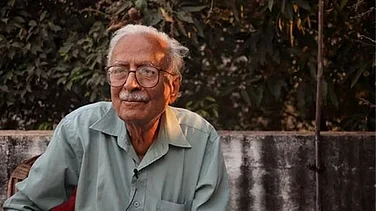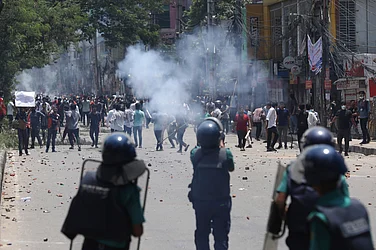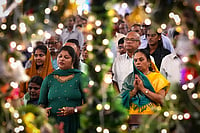Kashi is one of the oldest cities in the world. Its name is mentioned in the Rig Veda, where it’s called a moksha nagri, for it is believed that whosoever dies in Kashi attains immediate salvation. Therefore, Hindu believers in their old age prefer to surrender their life to God at Kashi. The Kashi Vishwanath Temple is of utmost religious importance in the Hindu religion. Many great saints like Adi Shankaracharya, Goswami Tulsidas, Ramakrishna Paramhansa, Swami Dayananda Saraswati, Swami Vivekananda and Guru Nanak had come to Varanasi to bathe in the holy waters of the Ganges, followed by darshan of the holy jyotirlinga.
In Sanskrit, vapi means a well, and gyan means the knowledge that liberates. Thus, gyanvapi refers to a well of knowledge. It was created at a time when even the holy Ganges had not descended to earth. Lord Shiva dug this well with his trishul to get water for his puja. He then delivered a spiritual sermon to his consort Parvati. Thus, the well came to be known as gyanvapi.
The Skanda Purana says:
Yoashtmurty Mahadev Purane Paripathyate
Tasheyshyam Ambumayi Murtrigyanda Gyanvapika
[The water of Gyanvapi is Shiva himself
The bestower of knowledge]
The first demolition
There was a magnificent temple of Lord Shiva at the very place where the Gyanvapi mosque stands today. This temple was built by Vikramaditya. In 1194, Qutubuddin Aibak defeated Jay Chandra in the battle of Asani and captured Banaras. According to Taj-ul-Maasir, a book by Hasan Nizami, “From there [Asani], the royal army marched towards Banaras, which is the centre of Hindustan. Here the army demolished around 1,000 temples”, including, it is claimed, Kashi Vishwanath.
In 1296, during the rule of Iltutmish, the Hindu business community bribed royal officers to rebuild the Kashi Vishwanath temple.
The second demolition
Mahmud Sharqi became an independent ruler of Jaunpur. During his reign, from 1436 to 1458, he demolished many temples in Banaras, including the Kashi Vishwanath.
The temple was rebuilt some 125 years thereafter by Gobardhan Das, son of Raja Todarmal, after the former’s victory in the battle of Munger. The dimensions and other details of this temple are available in Moti Chandra’s book, Kashi Ka Itihas.

The third demolition
According to Saqi Musta’idd, a historian who was Aurangzeb’s contemporary, “On 17 Jilqda, Hijri 1079 [April 18, 1669] the emperor learnt that... in Banaras, the stupid Brahmins teach their worthless book in schools, and both Hindu and Muslim students come to these schools from far off areas to acquire the Satanic knowledge. Upon hearing this, the emperor, the preserver of religion, issued an order to the scholars to demolish all schools and temples of the non-believers.”
The Kashi Vishwanath temple was also demolished, and the Gyanvapi mosque was erected on the pillars and from the debris of the temple, at the same place.
In 1777, Maharani Ahilya Bai Holkar of Indore revived the Kashi Vishwanath temple adjacent to the Gyanvapi mosque. Maharaja Ranjit Singh of Punjab donated 821 kg of gold in 1839 for the decoration of the two spires of the temple.
An open wound
When the Places of Worship (Special Provisions) Act, 1991, was debated in Parliament, Sadhvi Uma Bharti spoke for the BJP. She described her experience of her first visit to Kashi Vishwanath:
“...I went to Varanasi to visit Gyanvapi, to which I have never been... I saw the mosque built on the remnants of the temple, some sort of current of anger ran through my body. I felt disgraced at the fate of my ancestors, who I think were challenging my womanhood and asking me, whether the intention of Aurangzeb was merely to build a mosque, then why were remnants of the temple left. Was not the intention of Aurangzeb behind leaving remnants of the temple at the site of the mosque to keep reminding Hindus of their historical fate and to remind coming generations of Muslims of their past glory and power?”
“This is clearly a reflection of the evil designs of Aurangzeb and the Britishers. I would like to know from the movers of the Bill—the Congress (I) government—why they want to preserve and protect a wrong done by Aurangzeb and Britishers. Why are they keeping the bone of contention alive?
“...In our villages, bullock cart owners make a wound on the back of the bullock. When they want their cart to be pulled faster, they strike at the wound. Similarly, these disputes are wounds and marks of slavery on Bharat Mata. So long as Gyanvapi continues in its present condition at Banaras... it will remind us of Aurangzeb’s atrocities, including his efforts to convert Hindus to Islam, and this would be very painful.”
The Shringar Gauri
The western wall of Gyanvapi mosque is from the older temple. On its outer surface is an image of Shringar Gauri (Maa Parvati). Till about 1992, Hindus were allowed to worship the idol of Shringar Gauri and offer it vermilion on all 365 days of the year. However, from 1992, the administration has arbitrarily restricted the Shringar Gauri puja to just the fourth day of both Navratras (Chaturthi). Shringar Gauri was worshipped on this wall in 1947 too. The Places of Worship (Special Provisions) Act, 1991, does not prohibit this. The puja should be resumed on all 365 days.
The survey
Several suits have been filed for the right to worship at the original Shiva temple i.e., the Gyanvapi. The Varanasi court ordered a videographed survey of the Gyanvapi complex. This was opposed and even physically resisted by the Anjuman Intezamia Masjid Committee, which also challenged the survey order in the Allahabad high court. The high court heard the parties, considered the matter and found the order for conduct of survey as lawful.
Despite the high court negating their challenge, Intezamia Committee members declared they wouldn’t permit it, and that they were ready to face the consequences. The survey order was then taken to the Supreme Court, where it was mentioned in the CJI’s court when the request for a stay on the order was filed. The Supreme Court did not stay the survey order.
The police and administration were successful in ensuring that the survey was completed. The survey team has found (i) debris of the temple containing Hindu motifs; (ii) pillars of the original temple bearing Hindu symbols; and (iii) a Shivling that appeared once the wudu (ablution) tank was drained.
It was common for Mughals to leave the debris of a temple at captured sites itself, as also Hindu motifs on the pillars, so that every visitor of the conquered people could see these and feel the humiliation.
The Act does not apply to the Gyanvapi
1. Section 4(3) of the Act provides that it would not apply to any property regarding which any suit or appeal has been finally decided by a court before the commencement of this Act.
It may be recollected that one Din Mohammad had filed a suit with two others, claiming that the mosque and its entire enclosures was a waqf and that Muslims had the right to use the said property. The suit was dismissed. Din Mohammad appealed, but this too was dismissed. The judgment is reported as AIR 1942 Allahabad 353. The civil judge found that the mosque “was built on a site of a Hindu temple which was demolished by Emperor Aurangzeb in the 17th century”. The finding was not disturbed by the high court, which concurred with the finding that the entire enclosure was not in possession of the Muslim community, and that a portion of it was in possession of Hindus.
2. The Act also does not apply to any place of worship that is ancient, and is a historical monument or archaeological site/remains. As stated, the structures in Gyanvapi are constructed over pillars of an old temple, which are certainly over 100 years old and have an archaeological value.
3. The Act also does not apply to any place whereupon any other law is enforced for the time being. The Kashi Vishwanath temple is administered under the Uttar Pradesh Sri Kashi Vishwanath Temple Act, 1983.
An appeal to Muslims
The publishing house Voice of India brought out the book, The Hindu Temples And What Became Of Them. It contains a list of some 3,000 Hindu religious places that were demolished, destroyed or converted into places of another religion. This was done by violence, barbaric acts, murders, rape and loot. The memory of such incidents has been transmitted in the Hindu psyche from generation to generation, and is engraved in their subconscious minds.
Somehow, the three main temples—the Ram Janmabhoomi, the Krishna Janmabhoomi and the Kashi Vishwanath—have come to symbolise these acts of subversion, humiliation and inserts. Ram Janmabhoomi is back with Hindus. If Muslims voluntarily return Krishna Janmabhoomi and Kashi Vishwanath to Hindus with grace, the wounds of history may heal, and it may open the doors to lasting amity and goodwill between the two major communities of the country.
(This appeared in the print edition as "Past, Present & Future")
(Views expressed are personal)
Alok Kumar is a senior lawyer and international working president of the VHP





















